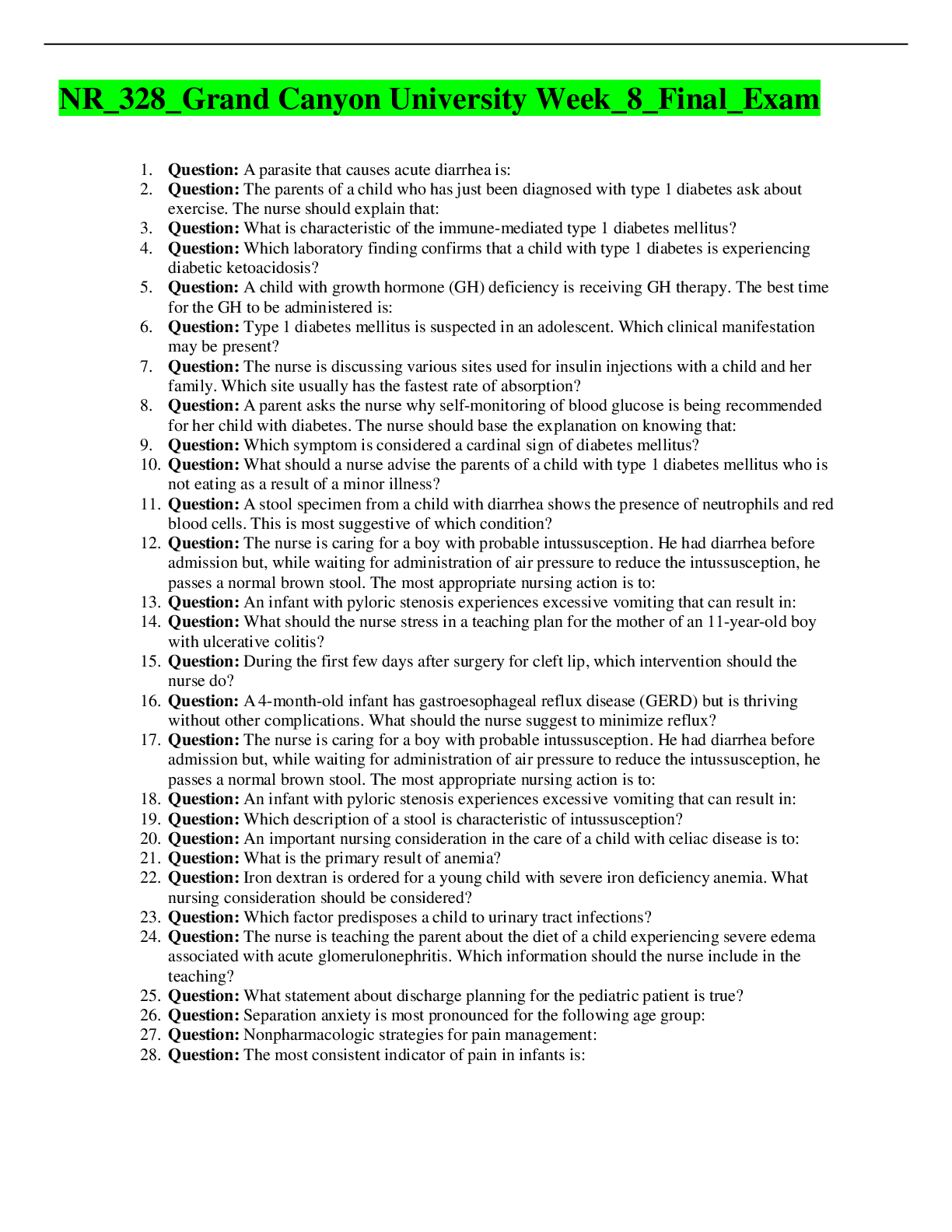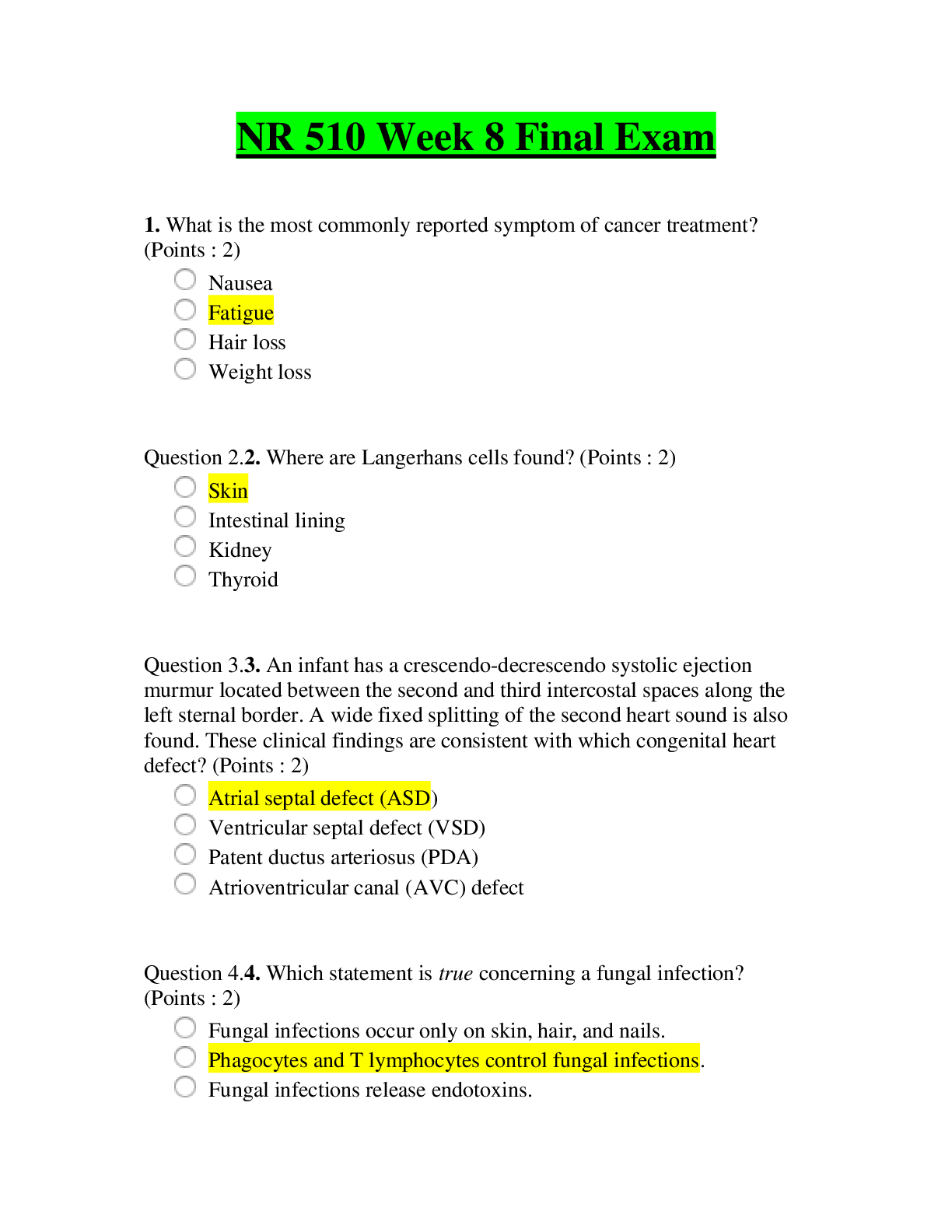Health Care > QUESTIONS & ANSWERS > ATI Cardiodynamics and Hemodynamics Regulation Chapter 5: Perrin: Understanding the Essentials of Cr (All)
ATI Cardiodynamics and Hemodynamics Regulation Chapter 5: Perrin: Understanding the Essentials of Critical Care Nursing: Chamberlain College of Nursing NR 341 (A Graded) Latest Questions and Complete Solutions
Document Content and Description Below
ATI Cardiodynamics and Hemodynamics Regulation Chapter 5: Perrin: Understanding the Essentials of Critical Care Nursing: Chamberlain College of Nursing NR 341 (A Graded) Latest Questions and Complete ... Solutions Perrin: Understanding the Essentials of Critical Care Nursing Chapter 5: Cardiodynamics and Hemodynamics Regulation MULTIPLE CHOICE. Choose the one alternative that best completes the statement or answers the ques 1) A patient has a blood pressure of 134/70 per blood pressure cuff and a blood pressure of 90/50 per arterial line. The nurse should: A) Discontinue the arterial line immediately. B) Check the level of the transducer and relevel and rezero the system. C) Do nothing because this is a normal variation between the two methods of measurement. D) Begin the infusion of a dopamine drip. Answer: B Explanation: A) The placement of the transducer is essential for accurate measurement. It must be level with the phlebostatic axis in order for the monitoring system to be accurate. #1 is not done at this time because the system needs to be assessed first. #3 is not correct becaus there is only a 5 to 15 mm Hg difference between the direct and indirect measurements. #4 is not correct because more information and data are needed before a vasoactive dru is used. Nursing Process: Implementation Cognitive Level: Analysis Category of Need: Physiologic Integrity–Physiologic Adaptation B) The placement of the transducer is essential for accurate measurement. It must be level with the phlebostatic axis in order for the monitoring system to be accurate. #1 is not done at this time because the system needs to be assessed first. #3 is not correct becaus there is only a 5 to 15 mm Hg difference between the direct and indirect measurements. #4 is not correct because more information and data are needed before a vasoactive dru is used. Nursing Process: Implementation Cognitive Level: Analysis Category of Need: Physiologic Integrity–Physiologic Adaptation C) The placement of the transducer is essential for accurate measurement. It must be level with the phlebostatic axis in order for the monitoring system to be accurate. #1 is not done at this time because the system needs to be assessed first. #3 is not correct becaus there is only a 5 to 15 mm Hg difference between the direct and indirect measurements. #4 is not correct because more information and data are needed before a vasoactive dru is used. Nursing Process: Implementation Cognitive Level: Analysis Category of Need: Physiologic Integrity–Physiologic Adaptation D) The placement of the transducer is essential for accurate measurement. It must be level with the phlebostatic axis in order for the monitoring system to be accurate. #1 is not done at this time because the system needs to be assessed first. #3 is not correct becaus there is only a 5 to 15 mm Hg difference between the direct and indirect measurements. #4 is not correct because more information and data are needed before a vasoactive dru is used. Nursing Process: Implementation Cognitive Level: Analysis Category of Need: Physiologic Integrity–Physiologic Adaptation 2) The nurse is monitoring a patient's pulmonary vascular resistance. Which value is the normal value? A) 100- 250 mm Hg B) 10- 250 dynes/sec/cm2 C) 400- 800 mm Hg D) 800- 1400 dynes/sec/cm2 Answer: B Explanation: A) The pulmonary system is a lo-wpressure system. The pressure of the vascular system is measured in dynes/sec/c2mdue to factors of flow, resistance, and time. #1 and #3 are not correct because mm Hg is used to measure pressure only. #4 is not correct because this the value for SVR. Nursing Process: Assessment Cognitive Level: Analysis Category of Need: Physiological Integrity–Physiological Adaptation B) The pulmonary system is a lo-wpressure system. The pressure of the vascular system is measured in dynes/sec/c2mdue to factors of flow, resistance, and time. #1 and #3 are not correct because mm Hg is used to measure pressure only. #4 is not correct because this the value for SVR. Nursing Process: Assessment Cognitive Level: Analysis Category of Need: Physiological Integrity–Physiological Adaptation C) The pulmonary system is a lo-wpressure system. The pressure of the vascular system is measured in dynes/sec/c2mdue to factors of flow, resistance, and time. #1 and #3 are not correct because mm Hg is used to measure pressure only. #4 is not correct because this the value for SVR. Nursing Process: Assessment Cognitive Level: Analysis Category of Need: Physiological Integrity–Physiological Adaptation D) The pulmonary system is a lo-wpressure system. The pressure of the vascular system is measured in dynes/sec/c2mdue to factors of flow, resistance, and time. #1 and #3 are not correct because mm Hg is used to measure pressure only. #4 is not correct because this the value for SVR. Nursing Process: Assessment Cognitive Level: Analysis Category of Need: Physiological Integrity–Physiological Adaptation [Show More]
Last updated: 2 years ago
Preview 1 out of 25 pages

Buy this document to get the full access instantly
Instant Download Access after purchase
Buy NowInstant download
We Accept:

Reviews( 0 )
$13.00
Can't find what you want? Try our AI powered Search
Document information
Connected school, study & course
About the document
Uploaded On
May 24, 2021
Number of pages
25
Written in
Additional information
This document has been written for:
Uploaded
May 24, 2021
Downloads
0
Views
79


 Questions and Answers (latest Update), All Correct, Download to Score A.png)






, (A Grade), Questions and Answers, All Correct Study Guide, Download to Score A.png)
, Questions and Answers, All Correct Study Guide, Download to Score A.png)
, Latest Questions and Answers with Explanations, All Correct Study Guide, Download to Score A.png)


 Questions and Answers (latest Update), 100% Correct, Download to Score A.png)
.png)

 Questions and Answers (latest Update)Download to Score A.png)
 Correct Study Guide, Download to Score A.png)
 FINAL TEST 1, Latest Questions and Answers with Explanations for Revision, All Correct Latest Review, (Latest 2021) Correct Study Guide, Download to Score A.png)

 Correct Study Guide, Download to Score A.png)
 Correct Study Guide, Download to Score A.png)

